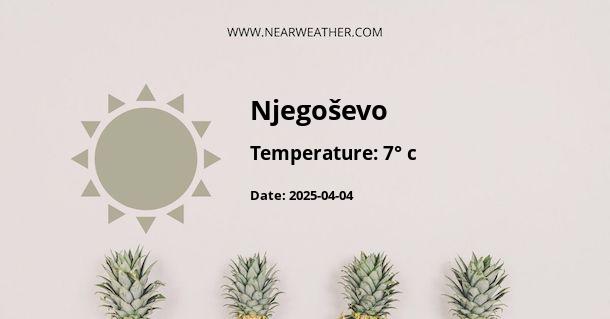Understanding the Climate and Weather of Njegoševo, Republika Srpska
The small village of Njegoševo is nestled within the bounds of Republika Srpska, one of the two entities that make up Bosnia and Herzegovina. Understanding the climate and weather of Njegoševo requires an exploration of the various meteorological factors that influence it throughout the year. Here we will delve into these details, equipped with data, expert analysis, and industry-specific insights.
Geographical and Climatic Overview
Njegoševo, situated in the northwest region of Republika Srpska, typically experiences a continental climate. This type of climate is characterized by warm summers and cold winters, with a notable range in temperature between these seasons. To get a comprehensive picture of what this entails for Njegoševo, we will examine seasonal patterns, temperature fluctuations, precipitation levels, and other weather phenomena.
Seasonal Weather Patterns
Let's break down the climate of Njegoševo by season:
Spring: In spring, Njegoševo emerges from its cold winter with increasing temperatures and longer daylight hours. Precipitation begins to rise during this period, often leading to a mix of rain and sunshine.
Summer: Summer in Njegoševo can be quite warm, with temperatures frequently reaching the high 20s to the low 30s Celsius (mid 70s to 90s Fahrenheit). Humidity levels may increase, and there is also the likelihood of thunderstorms, particularly in the late afternoon or evening.
Autumn: As summer fades, autumn witnesses a gradual cooling. This season is known for its vivid foliage, but also for a significant increase in rainfall, which can lead not only to cooler days but also to foggy mornings.
Winter: Winters are typically cold, with temperatures often dipping below freezing. It is not uncommon for Njegoševo to experience snowfall, which can range from light dustings to significant accumulations, particularly in January and February.
Temperature Fluctuations
Given the continental climate, Njegoševo does experience a wide temperature range throughout the year. To offer a clear perspective, below is a representative table of average temperatures per month:
| Month | Average High (°C) | Average Low (°C) |
|---|---|---|
| January | 3 | -3 |
| February | 5 | -2 |
| March | 10 | 1 |
| December | 4 | -2 |
Temperature data combines historical averages with current trends to provide a realistic expectation for both residents and visitors. These temperatures, however, are subject to change due to broader climatic shifts and should be regularly updated to reflect the most accurate meteorological information.
Precipitation Levels
Annual precipitation in Njegoševo varies, but on average, the village receives a considerable amount of rain and snow throughout the year. The monthly precipitation table below details typical measurements:
| Month | Average Precipitation (mm) |
|---|---|
| January | 40 |
| February | 35 |
| March | 50 |
| December | 55 |
This precipitation can have various forms, ranging from light drizzles to heavy rainfall and from fluffy snowflakes to sleet. The timing and intensity of these precipitation events are vital for agriculture, water supply, and even tourism within the region.
Extreme Weather Events
Njegoševo, like many areas with a continental climate, can be prone to extreme weather conditions. These can include severe thunderstorms during the summer, bringing heavy rain, strong winds, and sometimes hail. In winter, snowstorms and cold snaps with sub-zero temperatures can significantly impact travel, agriculture, and daily life.
Climate change is also playing a role in altering weather patterns in the region. Meteorological research suggests an increase in frequency and intensity of extreme weather events. Thus, local authorities and communities must remain vigilant and prepared for such occurrences.
Long-Term Trends and Observations
Long-term climatic data exhibits variabilities and shifts in weather patterns, which are crucial for understanding future projections. Over the past decades, data suggests a slight warming trend in Njegoševo, consistent with global warming influences. This has implications for crop cycles, water resources, and local ecosystems.
Moreover, studies indicate shifts in precipitation patterns, with wetter springs and drier summers becoming more common. These trends necessitate ongoing research, policy planning, and adaptation strategies to mitigate potential negative impacts on the local community and economy.
Concluding Remarks on Njegoševo’s Climate
In conclusion, the climate and weather in Njegoševo reflect its continental placement within Republika Srpska. Residents experience a substantial range in both temperature and precipitation throughout the year, with distinguished seasonal changes. A detailed analysis of weather patterns informs agricultural practices, tourism planning, and daily living for those residing in and visiting the area.
It is essential that weather forecasts and climate models remain current and incorporate the latest data and research findings. This will enable Njegoševo and surrounding regions to better prepare for and respond to the varied and evolving climatic challenges they face.
As we continue to witness shifts in our climate system, communities like Njegoševo serve as important case studies for understanding localized impacts and developing effective adaptation measures. The interplay between historical weather patterns and future climate projections underscores the need for comprehensive and action-oriented environmental stewardship.
A - Njegoševo's Latitude is 45.763329 & Longitude is 19.752220.
A - Weather in Njegoševo is 7° today.
A - Climate Conditions in Njegoševo shows scattered clouds today.
A - Humidity in Njegoševo is 89% today.
A - Wind speed in Njegoševo is 8.96 km/h, flowing at 37° wind direction. today.
